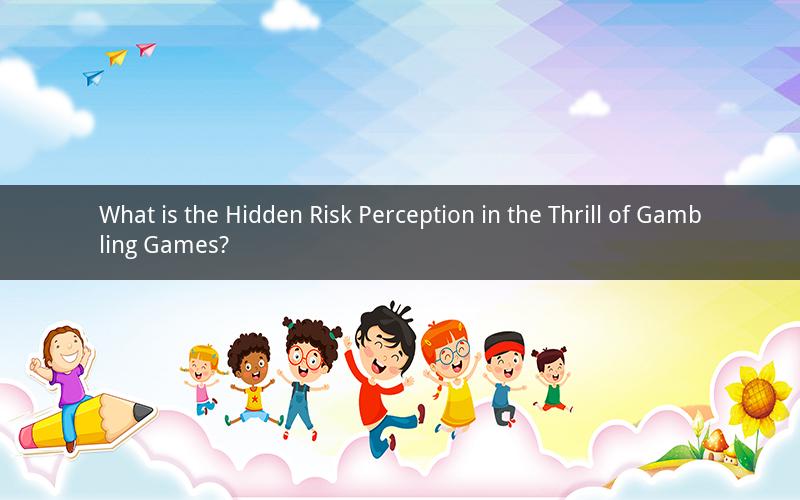
Table of Contents
1. Introduction to Risk Perception in Gambling
2. The Psychology Behind Risk Perception
3. The Role of Gamification in Risk Perception
4. Classic Examples of Risk Perception in Gambling Games
5. The Impact of Social Media on Risk Perception
6. The Diverse Perspectives on Risk Perception in Gambling
7. Real-Life Scenarios: Risk Perception in Action
8. The Fine Line Between Entertainment and Addiction
9. Strategies to Enhance Risk Perception in Gamblers
10. Conclusion
---
1. Introduction to Risk Perception in Gambling
Have you ever wondered what drives people to take risks in gambling games? The allure of potential rewards often overshadows the inherent risks involved. This article delves into the fascinating world of risk perception in gambling, exploring the psychological underpinnings, the role of gamification, and the impact of social media on this phenomenon.
2. The Psychology Behind Risk Perception
Risk perception is a complex psychological process that involves evaluating the likelihood and consequences of potential risks. In the context of gambling, individuals often perceive the potential rewards as outweighing the risks, leading to a skewed risk perception. This psychological bias is often attributed to the "near-miss" effect, where individuals are more likely to take risks when they have experienced a near win.
3. The Role of Gamification in Risk Perception
Gamification, the application of game design elements in non-game contexts, plays a significant role in shaping risk perception. By incorporating elements such as points, levels, and rewards, gamification creates a sense of progress and achievement, which can further reinforce the perception of low risk. However, this can also lead to a false sense of security and increased risk-taking behavior.
4. Classic Examples of Risk Perception in Gambling Games
One classic example of risk perception in gambling is the slot machine. The flashing lights, vibrant colors, and the anticipation of a big win create a thrilling experience that often overshadows the actual odds of winning. Another example is the lottery, where the allure of a life-changing jackpot can lead individuals to underestimate the slim chances of winning.
5. The Impact of Social Media on Risk Perception
Social media has a profound impact on risk perception in gambling. The constant exposure to stories of big wins and the glorification of gambling can create unrealistic expectations and a skewed perception of the risks involved. Additionally, the ease of access to online gambling platforms through social media can further exacerbate the problem.
6. The Diverse Perspectives on Risk Perception in Gambling
The perception of risk in gambling is not uniform. Some individuals may view gambling as a form of entertainment, while others may see it as a potential addiction. This diversity of perspectives highlights the complex nature of risk perception in gambling.
7. Real-Life Scenarios: Risk Perception in Action
Consider the scenario of a young professional who regularly plays online poker. Despite knowing the odds of winning, the thrill of the game and the potential for big wins often override the risks. This scenario reflects the power of risk perception in gambling.
8. The Fine Line Between Entertainment and Addiction
The fine line between entertainment and addiction in gambling is often blurred. While some individuals may engage in gambling as a form of entertainment, others may develop an addictive behavior, leading to significant personal and financial consequences.
9. Strategies to Enhance Risk Perception in Gamblers
To enhance risk perception in gamblers, several strategies can be employed. These include educating individuals about the odds of winning, promoting responsible gambling practices, and providing support for those struggling with gambling addiction.
10. Conclusion
The world of gambling is a complex tapestry of risk perception, psychology, and social influence. By understanding the factors that contribute to risk perception in gambling, we can better navigate the challenges and potential pitfalls of this entertaining yet risky activity.
---
Questions and Answers
1. Question: How does gamification influence risk perception in gambling games?
Answer: Gamification influences risk perception by creating a sense of progress and achievement, which can lead individuals to underestimate the risks involved.
2. Question: What is the "near-miss" effect, and how does it relate to risk perception in gambling?
Answer: The "near-miss" effect is a psychological phenomenon where individuals are more likely to take risks after experiencing a near win, leading to a skewed perception of risk in gambling.
3. Question: How does social media impact risk perception in gambling?
Answer: Social media impacts risk perception by exposing individuals to stories of big wins and the glorification of gambling, which can create unrealistic expectations and a skewed perception of the risks involved.
4. Question: What are some strategies to enhance risk perception in gamblers?
Answer: Strategies to enhance risk perception include educating individuals about the odds of winning, promoting responsible gambling practices, and providing support for those struggling with gambling addiction.
5. Question: How can the fine line between entertainment and addiction in gambling be identified?
Answer: The fine line between entertainment and addiction in gambling can be identified by assessing the individual's level of control over their gambling behavior, the impact of gambling on their personal and financial life, and the presence of any negative consequences.